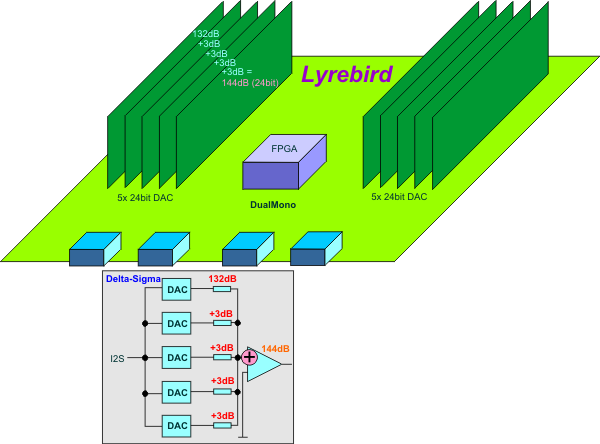|
This is still a concept site. It will be updated in parallel with the project progress.
The goal of the project is:
I want to create a new digital DAC sound card solution, even better as the T-DAC, RPi-DAC
It should be able to reproduce any sound and song I want to listen to, in the best achievable manner, even like a Lyrebird.
- create a True24 bit DAC which can really provide a 24bit resolution
- keep a modular concept so that it can be customized for interface, resolution, costs ...
- use an FPGA in order to feed the DACs, with filtering, control, synchronisation ...
- it results in supporting a real 144dB SNR figure and to consider the noise on all components
|
|
There are two approaches to achieve the goal:

|

|
|
DualMono and many DAC modules as needed
- use PCM1794 DAC in DualMono mode
- use so many DACs so that we can gain +3dB for every DAC added
- it might result in using 5 DACs per channel, in total 10
|
2x 16bit High Voltage DAC with analog signal combination
- use high voltage DACs in order to keep the output signal away from noise
- combine two 16bits and add the output voltage in a way that a 24bit digital value is converted
|
Pros
- the same DAC module can be used, highly customizable, e.g. different resolution (costs)
- native support of 192KHz sample rate
- well proven concept, e.g. RPi-DAC DualMono
|
Pros
- less modules needed, potentially an even higher bit resolution is possible (EOB), e.g. 28bit
- working as a Non-OverSampling (NOS) DAC
- easier to keep the output signal away from the noise (high voltage)
- less modules needed, smaller and more cost-effective
- DAC might be more linear, less DAC errors, possible to skip faulty LSBs
|
Cons
- much more modules and components (costs) needed
- still an oversampling, delta-sigma DAC (even FPGA could help)
|
Cons
- needs justification (trim), high quality (low tolerance) circuits (e.g. the voltage divider), e.g. use 0.01% R
- might support up to 96KHz sample rate, not 192KHz or higher (but OK)
- effort to convert I2S to SPI and to sync the DACs (FPGA, micro-controller)
|
|

